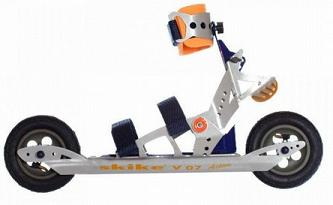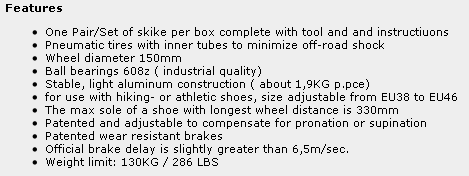When Parrish Sims from Fresno, CA asked if I gave "skike" lessons, I was embarrassed by my ignorance. However, the only Wikipedia entry I could find is written in German and I found only 3 Tweets as of this writing. Like its name implies, this discipline combines components of skating and biking. Skike-style skates  are ideal for rough and off-road surfaces because they are equipped with a pair of 6 inch inflatable tires, one in front and one in back, that cushion the ride. See Powerslide's Nordic Cross Skating video to see demonstrations of essential stride, braking and turning techniques.
are ideal for rough and off-road surfaces because they are equipped with a pair of 6 inch inflatable tires, one in front and one in back, that cushion the ride. See Powerslide's Nordic Cross Skating video to see demonstrations of essential stride, braking and turning techniques.

Parrish told me that in a past life he was an avid aggressive skater, so clearly he had a background of solid inline skating skills. Because neither of us could find a skiking instructor in the US, after I offered some tips about how inline technique and safety gear might apply, I asked him to keep me posted on his learning progress. Welp, as he might say, he feels "completely competent" today. Impressive! Below are the most illuminating tidbits from his progress reports, edited for clarity and brevity.
Parrish's Email Updates
May 29: Skike physics seem to alter slightly from regular inline skates because of the long footprint. My first experience trying to turn like I do on rollerblades ended with me on the ground. Most of my near spills so far were saved by my poles and the extra-long footprint. That and the pneumatic wheels really help out on rough terrain. I am working on my stride because the long frame plus the extra weight from the skike reduces how much force you can apply.
June 9: I forgot everything I knew from inlines when I stepped on these things. I was a little discouraged last week because I seemed to be getting worse and worse, including my balance. But the more mistakes I discover and correct, the more fun it gets. All those muscles working brings a newfound sense of energy-sapping, which lets me know this is the best workout I ever had. I can ride practically anywhere a bike can. You can adjust the difficulty by adjusting how much air is in the tires. The lower the pressure, the harder you have to work. Keeping knees bent and weight on the heel is important. Because of the long footprint, your stride and angles are that much more critical, and it's hard to change course in the middle of a stroke once you've committed.
June 22: I have great balance now. I even graduated to jumping small obstacles like curbs and stuff that gets in my way.
June 26: I found out the American Nordic Walking Association has an event coming up on Oct 23-25 for Nordic Fitness in the LA area. Classes will be held for Trekking, Nordic Blading and Skiking. The instructor for the skike class is coming from Germany so I have to be there to pick his brain as much as I can. I might even see what us Americans have to do to get certified without having to fly to Germany. Then I could be a certified skiker!
June 27: My form is great now and my strokes feel good. My muscles are getting used to it. I kept running out of breath so I need to build that part up through aerobic exercise. Skiking seems a lot like blading now that I'm used to the longer foot print and air tires. The better I get, the longer my stride gets. You can even stroke like a speed skater if you like, with the support leg bent at 90 degrees. My max speed today on a straight away was 15mph with an average of 5.8 mph.
July 26: This morning my pole tips are sticking incredibly well from my sharpening. Overall, the hard part of skiking is the Nordic part. Even though you can skike on urban roads without the poles, it is much easier with them and practically necessary for off road. It took me a couple of days to decipher the videos I watched so I could mimic the poling techniques. After a few weeks of perfecting my balance, I am now fairly proficient.
July 5: I decided to skike around my neighborhood. I wanted to see how these things performed in the obstacles of urban travel. Needless to say, they performed awesome. Bumpy road was no issue whatsoever; however going from a complete stop to motion feels like rolling too slow over cracks in the sidewalk. The big thing was people staring with their jaws wide open like they were trying to catch flies. Of course I did the same thing when I first saw a video of skiking. Oh, here is some fitness news: with just skiking on the weekends, I have lost a total of 10 lbs. I have not changed my eating habits or anything. I can now skike at the same speed as I used to on my inlines, and can sustain that cruising speed for quite awhile.
Due to skike skates being new in the US, I had to learn everything on my own through tips from a friend in the eastern states, and by watching YouTube videos. My enthusiasm to stick with it has paid off—although because I am self-taught, some of my information may not be exactly right.
About the Poles
Parrish started out with the Skike One 4 You poles but did not like these because he couldn’t keep the tips sharp enough to prevent slippage on smooth pavement. Hoping to find replacement poles by Leki or Exel, he learned that these two manufacturers don’t appear to be selling their Nordic blading poles in the US anymore. He turned to Swix Roller Ski poles. Swix is a major manufacturer of quality cross country ski poles which can be equipped with roller ski ferrule tips. His new Swix poles arrived on August 5 and he’s very happy with these.
Skike poles should be sized at 90% of your height, plus or minus 5cm. They can help with stumbles but if your rhythm is off, may cause balance issues. Keeping weight over the skike, you push back with the pole as you stroke, transferring your weight onto the lead leg. For fast skiking, try planting the tip further back to add stroke power. “When I am climbing,” Parrish commented in one update, “one of my poles seems to be planting more parallel to me and perpendicular to the ground. That is also needed for the 2:1 asymmetrical stride. Learning all the strides is necessary, as you will need different techniques for different situations.”